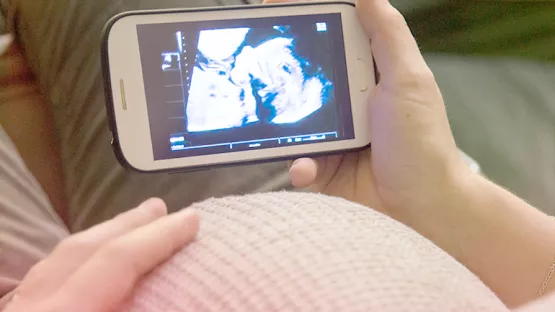A typical pregnancy normally lasts from 37 to 42 weeks, counting from the first day of your last period. When you’re pregnant, your body will go through a number of important changes each month. Here’s an outline of what you can expect during the different months and weeks in a pregnancy calendar.
Pregnancy calendar
Trimester 1 (Month 1 - 3)
In the first trimester of pregnancy, the fertilised egg implants in the uterus, and your child's major organs and body systems start to form rapidly. Morning sickness and fatigue are common symptoms during this time as the body adjusts to the changes of pregnancy6 .
Month 1
- Start of first trimester
- For most, this is the month you discover you’re pregnant.
- Your child is only 0.1 to 0.2 mm.
- You may be prescribed prenatal vitamins and folic acid.
Month 2
- Your child is now a little under an inch long.
- Your child’s heart is beating, the brain is developing, and has developed all limbs. The eyes have not fully developed.
- You may experience moodiness as hormone levels adjust.
- Nausea, vomiting, food sensitivity and fatigue may develop, or become more severe.
- Start budgeting, and explore your options for birth plans.
Month 3
- Nausea may decrease as your body adjusts to hormone levels.
- By the end of the first trimester, your child is fully developed.
- You will be able to hear your child’s heartbeat.
- Your child is between 2 and 4 inches long.
- You may experience your first food cravings as appetite returns.
Trimester 2 (Month 4 - 6)
In the second trimester of pregnancy, your child's organs continue to develop and mature, and the mother usually experiences reduced morning sickness and increased energy. Your child's movements become more noticeable, and the belly starts to visibly grow as the pregnancy progresses6 .
Month 4
- Start of the second trimester in the pregnancy calendar.
- Experience first flutters of child’s movement, often described as “butterflies” or “bubbles”.
- Nausea usually subsides and energy increases.
- You may develop heartburn as your uterus rises in the abdomen.
- Consider signing up for prenatal classes.
Month 5
- Appetite often increases.
- Fatigue may return, as you’re carrying extra weight.
- You may experience bloating, and constipation.
- Some will experience forgetfulness, also known as “pregnancy brain”.
- Your child is now about 6 to 9 inches long, and has developed fingerprints.
Month 6
- Your uterus is the size of a basketball resting above your belly button.
- Skin on the stomach may feel itchy as it stretches around your womb.
- Bleeding gums, constipation, heartburn and leg cramps, may intensify.
- Your child is about 10 inches long.
- You’ll be aware when your child stretches and hiccups at this stage of the pregnancy calendar.
- Plan your maternity leave with your employer.
Trimester 3 (Month 7 - 9)
In the third trimester of pregnancy, your child's growth accelerates, and the mother may experience discomfort due to the increasing size of the belly. Braxton Hicks contractions may occur as the body prepares for labour, and your child settles into a head-down position in readiness for birth6 .
Month 7
- Your feet or hands may start cramping.
- You may experience more of your child’s movements.
- Many experience Braxton Hicks contractions (non-productive contractions).
- Your child is almost 12 inches long.
- Your child can now see, hear, and taste.
Month 8
- You may experience discomfort as your child pushes against your rib cage or organs.
- Pelvic pressure may increase as your child drops into this area.
- Indigestion and heartburn may become more intense.
- Braxton Hicks contractions become more regular.
- Your child may be 12 inches or longer.
- By the end of the 8th month in the pregnancy calendar, most babies descend head-down into the pelvic area.
Month 9
- You breathe a little easier as your child settles into the pelvis, giving you more room in the abdominal area.
- Sleep will become more difficult due to your belly’s size.
- Your weight gain will be as high as it will go; up to 35 pounds on average.
- Your child will be about 18 to 21 inches long.
- Your child’s brain is growing rapidly at the last month of the pregnancy calendar.
Frisomum® Gold – Our Formula Milk Alternative During Your Pregnancy
To address the specific needs of mums-to-be, maternal milk is often recommended as it helps balance both your and your child’s nutritional needs safely. We have formulated Frisomum® Gold with both mum and child in mind, and its unique Dual Care+ formula supports you on your pregnancy journey. Some of the vital nutrients that Frisomum® Gold provides you with include:
Vitamin D - Vitamin D is necessary for the absorption and utilisation of calcium and phosphorus1 .
Calcium - Helps in the normal growth and development of bones and teeth2 .
Vitamin B12 - Needed for red blood cell production and the healthy functioning of the nervous system3 .
Folic Acid - Folic acid is essential for growth and division of cells. Folate plays a role in the formation of red blood cells. Folate helps to maintain the growth and development of the foetus4 .
Iodine - Essential for the formation of thyroid hormones, which supports brain development5 .
Low glycemic index - The glycemic index (GI) is a rating system for foods containing carbohydrates. It shows how quickly food affects your blood sugar (glucose) level when eaten on its own. The low glycemic index (GI) could help the mother avoid being overweight during pregnancy.
When you consider pregnancy milk powder, it is also best to consider the origins of the milk, the process of manufacturing, and nutrient content as well as one which helps you control weight gain during pregnancy. Frisomum® Gold preserves the natural nutrients of the milk to give you what you need in your pregnancy journey. Now that you are aware of the importance of maternal milk/susu, check out what Frisomum® Gold has to offer now!
References:
- Vitamin D. (2022). Retrieved 14 June 2022, from https://www.hsph.harvard.edu/nutritionsource/vitamin-d/
- Calcium. (2022). Retrieved 14 June 2022, from https://www.hsph.harvard.edu/nutritionsource/calcium/
- B Vitamins. (2022). Retrieved 14 June 2022, from https://www.hsph.harvard.edu/nutritionsource/vitamins/vitamin-b/
- https://www.nhs.uk/pregnancy/keeping-well/vitamins-supplements-and-nutrition/#:~:text=Folic%20acid%20before%20and%20during,tube%20defects%2C%20including%20spina%20bifida.
- https://www.health.nsw.gov.au/kidsfamilies/MCFhealth/maternity/Pages/iodine-supplements-factsheet.aspx#:~:text=How%20much%20iodine%20do%20pregnant,micrograms%20per%20day%20when%20breastfeeding.
- https://www.medicalnewstoday.com/articles/323742



